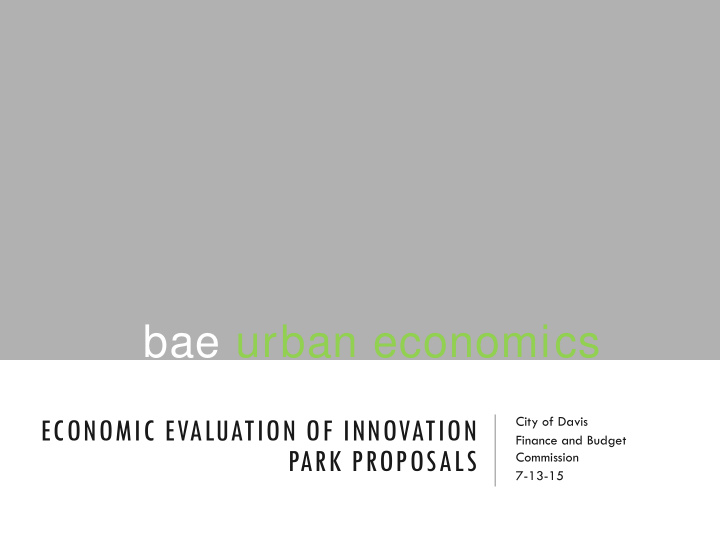



bae urban economics ECONOMIC EVALUATION OF INNOVATION City of Davis Finance and Budget PARK PROPOSALS Commission 7-13-15
REPORT OVERVIEW Innovation Parks as an Economic Development Strategy Local Baseline Conditions Potential Growth in Local Demand for Business Park/Tech Space Potential Employee Housing Demand by 2035 and Buildout Internal Demand For Ancillary Retail and Lodging by 2035 and Buildout Planning Considerations Reallocation of Regional Employment Growth Projections
INNOVATION PARK SCENARIOS 1 . Mace Ranch Innovation Center (MRIC) Alone 2. Davis Innovation Center (Davis IC) Alone 3. Cumulative Scenario MRIC plus Mace Triangle properties Davis IC Nishi Property
INNOVATION PARK DEVELOPMENT ASSUMPTIONS Mace Cumulative Land Use Davis IC MRIC Triangle Nishi Scenario Office/Tech Lt. Ind. 3,680,000 2,394,000 45,901 352,950 6,472,851 (Sq. Ft.) Retail 120,000 100,000 25,155 47,950 293,105 (Sq. Ft.) Lodging 200 150 0 0 360 (Rooms) Total Non- Residential 4,000,000 2,654,000 71,056 409,900 7,125,956 (Sq. Ft.) (a) Residential 650 650 (Units) (a) Total non-residential square feet includes 360,000 lodging square feet.
CUMULATIVE SCENARIO WITHOUT DAVIS IC Mace Cumulative Land Use MRIC Triangle Nishi Scenario Office/Tech Lt. Ind. 2,394,000 45,901 352,950 2,792,851 (Sq. Ft.) Retail 100,000 25,155 47,950 173,105 (Sq. Ft.) Lodging 150 0 0 360 (Rooms) Total Non- Residential 2,654,000 71,056 409,900 3,125,956 (Sq. Ft.) (a) Residential 650 650 (Units) (a) Total non-residential square feet includes 160,000 lodging square feet.
RESEARCH APPROACH Review background materials/literature review Local conditions assessment Case studies of similar communities Interviews with local and regional experts Analysis of potential employee expenditures and business-related lodging demand Analysis of SACOG growth projections and local residential land supply
KEY FINDINGS UC Davis is a national and international research powerhouse University leadership is placing increased emphasis on tech transfer/commercialization and industry partnerships A local and regional innovation “ecosystem” is developing Davis has significant innovation-driven business activity but has had constraints on business recruitment, expansion, and retention Case study communities have historically captured substantially more business growth than Davis
KEY FINDINGS, MRIC ALONE Absorption likely to take about 19 years, resulting in up to about 5,900 new workers by buildout Internal demand sufficient to support proposed retail and lodging component Workforce housing demand: about 3,763 housing units. (About 45% would prefer to live outside of Davis.) Existing land could yield about 1,238 new housing units for MRIC employee households. (Remainder absorbed by households not affiliated with MRIC.) Other communities would need to accommodate demand for about 815 new housing units for MRIC employee households that would otherwise prefer to live in Davis.
KEY FINDINGS, CUMULATIVE SCENARIO (WITHOUT DAVIS IC) Absorption over about 21 years, resulting in up to about 7,500 new workers Internal demand sufficient to support proposed retail and lodging component Workforce housing demand: about 4,829 housing units. Nishi would add 650 housing units Other communities would need to accommodate demand for about 1,984 new housing units for MRIC, Mace Triangle, and Nishi employee households that would otherwise prefer to live in Davis
Recommend
More recommend